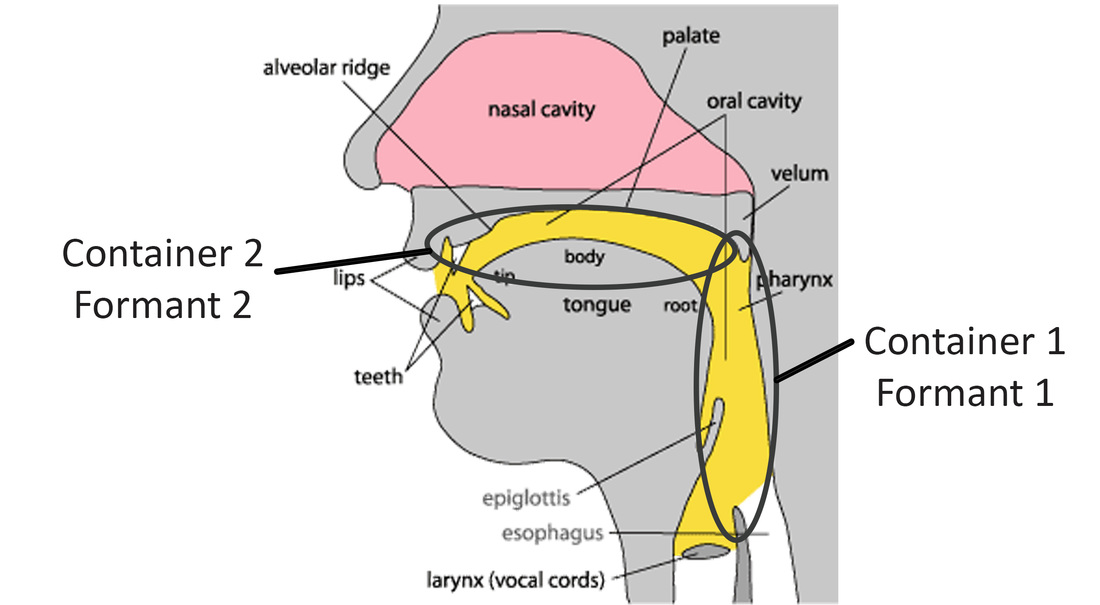The Resonant Voice
The resonator for the voice is called the vocal tract. Unlike a bottle, the vocal tract is made up of multiple containers of air (resonators) that vibrate at different pitches.
Our voice is a unique instrument. Unlike a guitar or piano, we can control and adapt the resonance in the vocal tract by changing the shape and size of the vocal track by changing the shape with our mouth, lips, tongue, neck, jaw and velum (soft palate).
Is the chest cavity a resonator?
When we sing lower notes, we can sometimes feel it in the chest area. That is how the term chest voice came about. This is actually sound waves traveling through the bones. The chest cavity is not a resonator as it does not have an opening for sound to escape and does not add to the overall sound.
What about head resonance?
Again, this is not a resonator and does not contribute to the overall sound. However, if it works for you, the feelings of resonance in your face and chest are a legitimate way of helping you find different tones and are often an indicator that resonance in your vocal tract is strong.
What about the nasal cavity?
This is a resonator. However, there is a lot of contradicting research of its viability as a resonator and as it is not adjustable for now, I will concentrate on the vocal tract.
As I said earlier the vocal tract is in fact made up of two resonators and we name the harmonic boosted in each area of the vocal tract formant 1 and formant 2.
Resonator 1
Image courtesy of Mike Gasser/Indiana University
• Behind the tongue, from the top of the larynx to the back of the tongue.
• Formant 1 is produced here and is the pitch of the air that vibrates in this space.
Resonator 2
• In our mouths, or to be more specific in front and above the tongue.
• Formant 2 is produced here and is the pitch of the air that vibrates in this space.
Why does this matter?
Depending on the different formant boosted, different tones and vowel sounds are formed and volume can be boosted.
from Encyclopedia Britannica http://www.britannica.com/topic/vowel/images-videos
For example
In the vowel for heed, eee or /i/
· Resonator 1 is large therefore formant 1 is low, in this case around 300Hz
· Resonator 2 is small therefore formant 2 in high, in this case around 2500hz
In the vowel for hawed, aw or /a/
· Resonator 1 is small therefore formant 1 is high, in this case around 800hz
· Resonator 2 in large therefore formant 2 is low, in this case around 1000hz
In the vowel for who’d, oo or /u/
· Resonator 1 is large therefore formant 1 is low, in this case around 300hz
· Resonator 2 is large therefor formant 2 is low, in this case around 900hz
Watch out for my next blog, in which I will help you discover what tones you can create and how to do it.
IF YOU HAVE ANY QUESTIONS PLEASE GET IN TOUCH OR BOOK A LESSON HERE.
SINGING LESSONS WITH BETH ARE AVAILABLE IN PLUMSTEAD, LONDON OR ONLINE VIA SKYPE.
References:
Voice Science Works: https://www.voicescienceworks.org/
The Naked Vocalists: https://www.thenakedvocalist.com/blog/
Practical Vocal Acoustics: https://www.amazon.co.uk/Practical-Vocal-Acoustics-Pedagogic-Applications/dp/157647240X/ref=sr_1_1?ie=UTF8&qid=1538584105&sr=8-1&keywords=kenneth+bozeman




